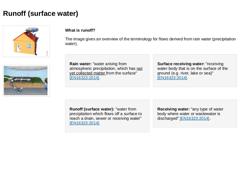
|
(Image: Surface water) (Image: Terms for flows derived from rain water according to DIN EN 752) What is runoff? The image gives an overview of the terminology for flows derived from rain water (precipitation water). Rain water: "water arising from atmospheric precipitation, which has not yet collected matter from the surface" [EN16323:2014]. Surface receiving water: "receiving water body that is on the surface of the ground (e.g. river, lake or sea)" … |
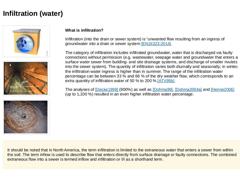
|
(Image: Infiltration of extraneous water) (Image: Infiltration into a brick sewer) (Image: Infiltration into a cast-in-place concrete sewer) What is infiltration? Infiltration (into the drain or sewer system) is “unwanted flow resulting from an ingress of groundwater into a drain or sewer system [EN16323:2014]. The category of infiltration includes infiltrated groundwater, water that is discharged via faulty connections without permission (e.g. wastewater, … |
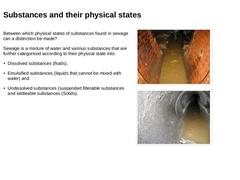
|
Between which physical states of substances found in sewage can a distinction be made? Sewage is a mixture of water and various substances that are further categorised according to their physical state into: -
Dissolved substances (fluids),
-
Emulsified substances (liquids that cannot be mixed with water) and
-
Undissolved substances (suspended filterable substances and settleable substances (Solids).
(Image: Wastewater) (Image: Wastewater) |
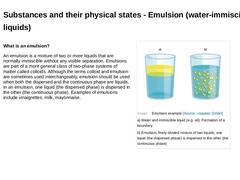
|
What is an emulsion? An emulsion is a mixture of two or more liquids that are normally immiscible without any visible separation. Emulsions are part of a more general class of two-phase systems of matter called colloids. Although the terms colloid and emulsion are sometimes used interchangeably, emulsion should be used when both the dispersed and the continuous phase are liquids. In an emulsion, one liquid (the dispersed phase) is dispersed in the … |
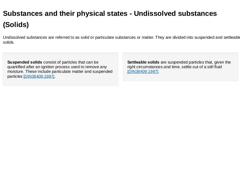
|
Undissolved substances are referred to as solid or particulate substances or matter. They are divided into suspended and settleable solids. Suspended solids consist of particles that can be quantified after an ignition process used to remove any moisture. These include particulate matter and suspended particles [DIN38409:1987]. Settleable solids are suspended particles that, given the right circumstances and time, settle out of a still fluid [DIN38409:… |
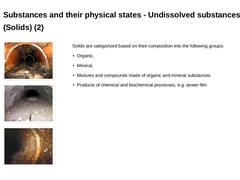
|
(Image: Deposits sewer - mixtures of organic and mineral substances) (Image: Mineral solids in the sewer line) (Image: Deposits in the sewer – sewer film) Solids are categorized based on their composition into the following groups: -
Organic,
-
Mineral,
-
Mixtures and compounds made of organic and mineral substances
-
Products of chemical and biochemical processes, e.g. sewer film
|
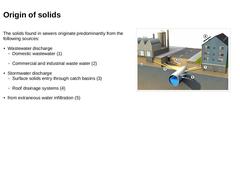
|
The solids found in sewers originate predominantly from the following sources: -
Wastewater discharge
-
Stormwater discharge
-
from extraneous water infiltration (5)
(Image: Origin of solids) |
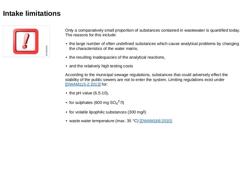
|
Only a comparatively small proportion of substances contained in wastewater is quantified today. The reasons for this include: -
the large number of often undefined substances which cause analytical problems by changing the characteristics of the water matrix,
-
the resulting inadequacies of the analytical reactions,
-
and the relatively high testing costs
According to the municipal sewage regulations, substances that could adversely … |
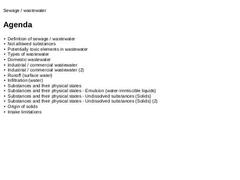
|
|
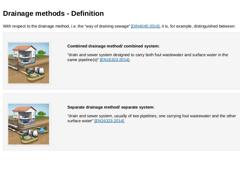
|
With respect to the drainage method, i.e. the “way of draining sewage” [DIN4045:2016], it is, for example, distinguished between: (Image: Combined system according to Girnau) Combined drainage method/ combined system: "drain and sewer system designed to carry both foul wastewater and surface water in the same pipeline(s)" [EN16323:2014]. (Image: Separate system according to Girnau) Separate drainage method/ separate system: "drain and sewer system, usually … |
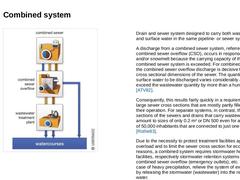
|
(Image: Schematic depiction of drainage in combined sewer systems - illustration of combined wasterwater overflow for peak flows) Drain and sewer system designed to carry both wastewater and surface water in the same pipeline- or sewer system. A discharge from a combined sewer system, referred to as a combined sewer overflow (CSO), occurs in response to rainfall and/or snowmelt because the carrying capacity of the combined sewer system is exceeded. … |
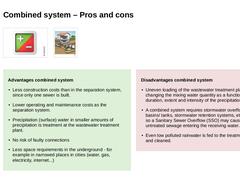
|
(Image: Pros and cons) (Image: Drainage of wastewater and surface water in combined systems) Advantages combined system -
Less construction costs than in the separation system, since only one sewer is built.
-
Lower operating and maintenance costs as the separation system.
-
Precipitation (surface) water in smaller amounts of precipitation is treatment at the wastewater treatment plant.
-
No risk of faulty connections
-
Less space requirements in the underground - …
|
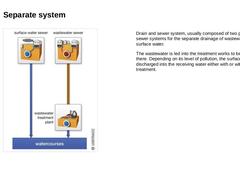
|
(Image: Schematic depiction of drainage in seperate systems) Drain and sewer system, usually composed of two pipe-or sewer systems for the separate drainage of wastewater and surface water. The wastewater is led into the treatment works to be treated there. Depending on its level of pollution, the surface water is discharged into the receiving water either with or without prior treatment. |
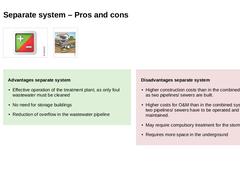
|
(Image: Pros and cons) (Image: Drainage of wastewater and surface water in separate system) Advantages separate system -
Effective operation of the treatment plant, as only foul wastewater must be cleaned
-
No need for storage buildings
-
Reduction of overflow in the wastewater pipeline
Disadvantages separate system -
Higher construction costs than in the combined system, as two pipelines/ sewers are built.
-
Higher costs for O&M than in the combined system, …
|
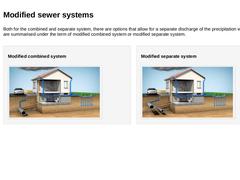
|
Both for the combined and separate system, there are options that allow for a separate discharge of the precipitation water. These are summarised under the term of modified combined system or modified separate system. Modified combined system (Image: Modified combined system) Modified separate system (Image: Modified separate system) |
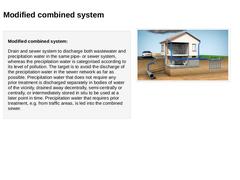
|
Modified combined system: Drain and sewer system to discharge both wastewater and precipitation water in the same pipe- or sewer system, whereas the precipitation water is categorised according to its level of pollution. The target is to avoid the discharge of the precipitation water in the sewer network as far as possible. Precipitation water that does not require any prior treatment is discharged separately in bodies of water of the vicinity, drained … |
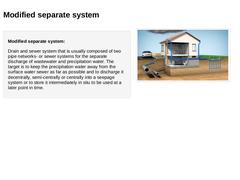
|
Modified separate system: Drain and sewer system that is usually composed of two pipe networks- or sewer systems for the separate discharge of wastewater and precipitation water. The target is to keep the precipitation water away from the surface water sewer as far as possible and to discharge it decentrally, semi-centrally or centrally into a seepage system or to store it intermediately in situ to be used at a later point in time. |
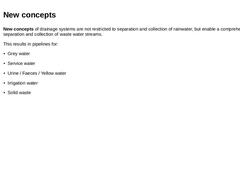
|
New concepts of drainage systems are not restricted to separation and collection of rainwater, but enable a comprehensive separation and collection of waste water streams. This results in pipelines for: |
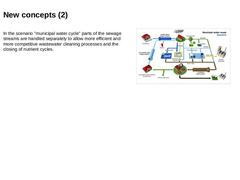
|
In the scenario "municipal water cycle" parts of the sewage streams are handled separately to allow more efficient and more competitive wastewater cleaning processes and the closing of nutrient cycles. (Image: Scenario "municipal water cycle") |
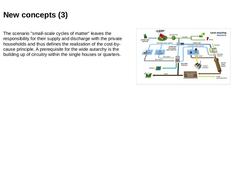
|
The scenario "small-scale cycles of matter“ leaves the responsibility for their supply and discharge with the private households and thus defines the realization of the cost-by-cause principle. A prerequisite for the wide autarchy is the building up of circuitry within the single houses or quarters. (Image: Local recycling scenario) |
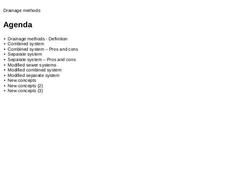
|
|

|
Congratulations! You have successfully finished this lesson. Next you will have the opportunity to review the newly acquired knowledge with an interactive questionnaire. You can of course still navigate back to any point in the lessons if you wish to review a specific point or subject. Stay curious! |

|
Drain and sewer systems are used for the collection and discharge of wastewater. The module provides basic knowledge about the objectives, functional requirements, design and operation, modes of operation, and drainage methods of drain and sewer systems. This module focuses exclusively on drain and sewer systems that are operated as gravity systems. After completing this module, you will have knowledge regarding: - boundaries, objectives, and functional requirements;
- structure and operation modes;
- types of operation and drainage methods of drainage systems.
|
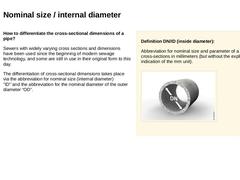
|
How to differentiate the cross-sectional dimensions of a pipe? Sewers with widely varying cross sections and dimensions have been used since the beginning of modern sewage technology, and some are still in use in their original form to this day. The differentiation of cross-sectional dimensions takes place via the abbreviation for nominal size (internal diameter) "ID“`and the abbreviation for the nominal diameter of the outer diameter “OD”. |
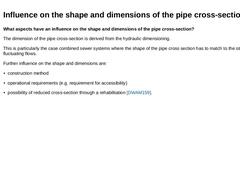
|
What aspects have an influence on the shape and dimensions of the pipe cross-section? The dimension of the pipe cross-section is derived from the hydraulic dimensioning. This is particularly the case combined sewer systems where the shape of the pipe cross section has to match to the strongly fluctuating flows. Further influence on the shape and dimensions are: |